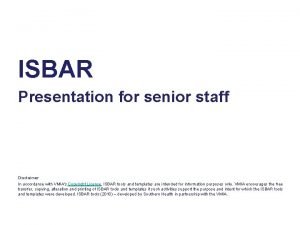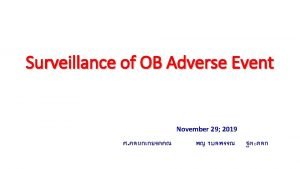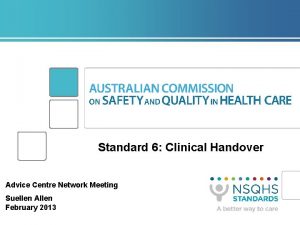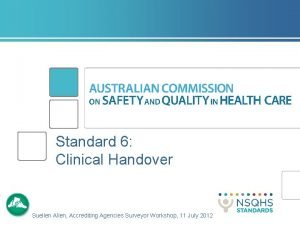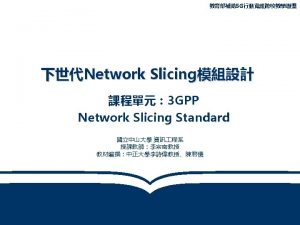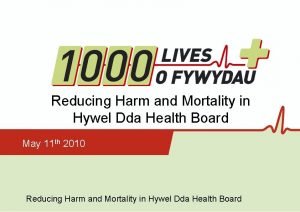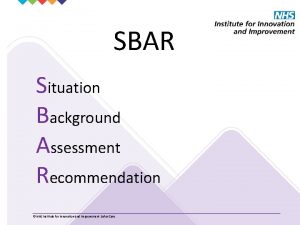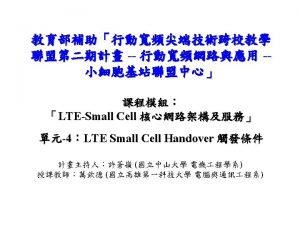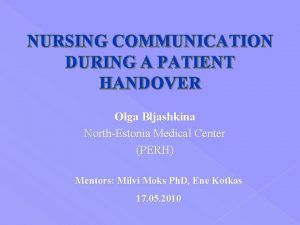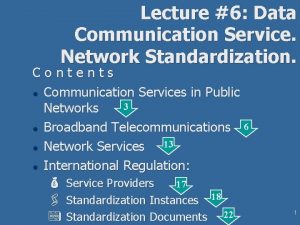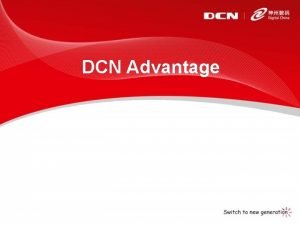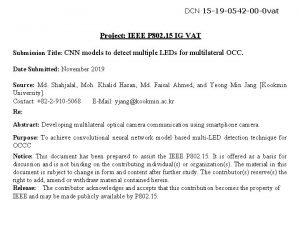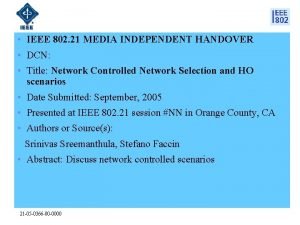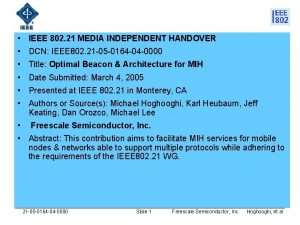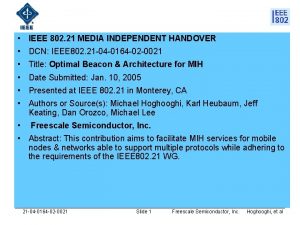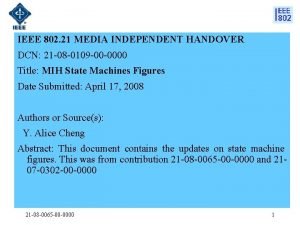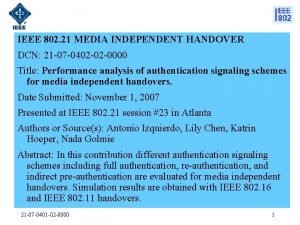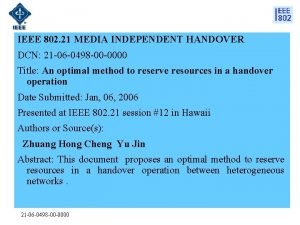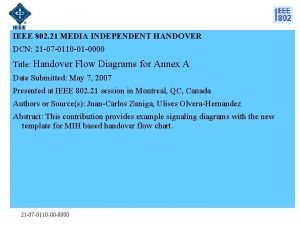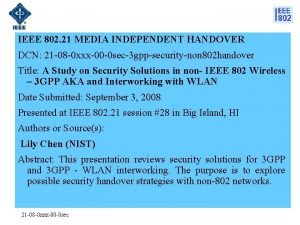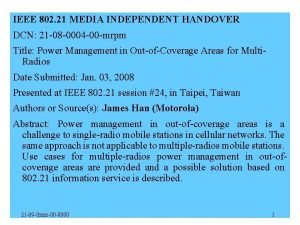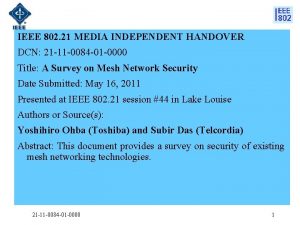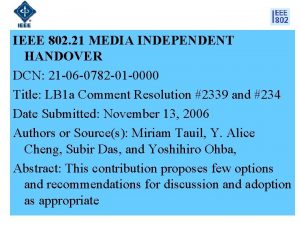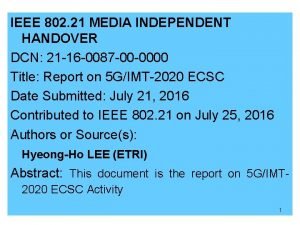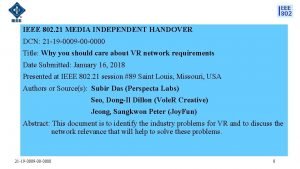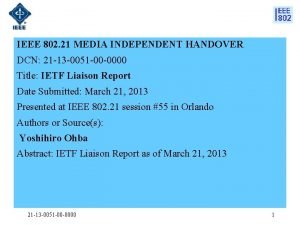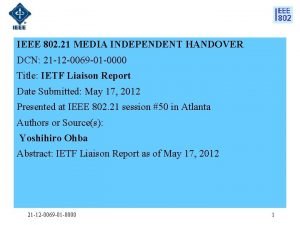IEEE 802 21 MEDIA INDEPENDENT HANDOVER DCN 21






























- Slides: 30

IEEE 802. 21 MEDIA INDEPENDENT HANDOVER DCN: 21 -10 -0135 -00 -srho Title: Introduction of 3 GPP IWLAN Architecture and SRVCC Date Submitted: 2010 -7 -10 Presented at IEEE 802 July Plenary Authors or Source(s): Dapeng Liu, Ge Liu(China Mobile) Abstract: Introduction of 3 GPP IWLAN and SRVCC architecture which is related to single radio handover. 1

IEEE 802. 21 presentation release statements This document has been prepared to assist the IEEE 802. 21 Working Group. It is offered as a basis for discussion and is not binding on the contributing individual(s) or organization(s). The material in this document is subject to change in form and content after further study. The contributor(s) reserve(s) the right to add, amend or withdraw material contained herein. The contributor grants a free, irrevocable license to the IEEE to incorporate material contained in this contribution, and any modifications thereof, in the creation of an IEEE Standards publication; to copyright in the IEEE’s name any IEEE Standards publication even though it may include portions of this contribution; and at the IEEE’s sole discretion to permit others to reproduce in whole or in part the resulting IEEE Standards publication. The contributor also acknowledges and accepts that this contribution may be made public by IEEE 802. 21. The contributor is familiar with IEEE patent policy, as stated in Section 6 of the IEEE-SA Standards Board bylaws <http: //standards. ieee. org/guides/bylaws/sect 6 -7. html#6> and in Understanding Patent Issues During IEEE Standards Development http: //standards. ieee. org/board/pat/faq. pdf> 2

Agenda • 3 GPP IWLAN Introduction • 3 GPP SRVCC Introduction 21 -09 -0198 -02 -srho 3

3 GPP IWLAN Introduction • 3 GPP TS 23. 327 • Mobility between 3 GPP-Wireless Local Area Network (WLAN) interworking and 3 GPP systems • 3 GPP TS 24. 327 • Mobility between 3 GPP-Wireless Local Area Network (WLAN) interworking and 3 GPP systems; Stage 3 Non-roaming reference model Protocol stack between the WLAN UE and the Packet Data Gateway 4

IWLAN Architecture HSS/HL R HSS/HLR WLAN UE WLAN Access Network 3 GPP AAA WAG PDG Architecture OCS PDG Packet Data Network WLAN UE WLAN Access Network 3 GPP AAA OCS TTG GGSN Packet Data Networ k TTG Architecture • PDG has both WAG and PGD function • TTG uses Gn’ interface connect to • PDG is introduced for WLAN access GGSN • Less impact of the current GGSN and • TTG has tunnel termination function • Reuse current 2/3 G network’s GGSN 2/3 G network • May has impact to the current GGSN 5

IWLAN Mobility Architecture • Stand alone HA(Home Agent) • UE should support DSMIPv 6(Dual Stack Mobile IPv 6) 6

IWLAN Mobility Architecture in deployment: HA co-located with GGSN • 3 GPP network as UE’s home network • WLAN network as UE’s foreign network 7

Attach procedure over 2 G/3 G for the GGSN and HA collocated scenario 8

• 1. The UE initiates the attach procedure at power on. The UE is authenticated and authorized to access the 2 G/3 G network according to TS 23. 060 [3]. SGSN may interact with the HLR for Authentication. • 2. The SGSN interacts with the HLR and updates the mobile node's location area as it is specified in TS 23. 060 [3]. SGSN receives the Subscriber Data from HLR. • 3. The UE initiates the PDP context activation procedure as it is specified in TS 23. 060 [3] to obtain the IP address. The Access Point Name (APN) specified by the service provider may be passed as a parameter. The UE shall leave the PDP Address empty to request a dynamic PDP address. • 4. • 5. The SGSN requests the selected GGSN to set up a PDP context for the UE as it is specified in TS 23. 060 [3]. • 6. If the GGSN can assign an address for the UE locally, it assigns the address and the GGSN creates a TEID for the requested PDP context. Otherwise the GGSN uses External PDN Address Allocation mechanism as it is specified in TS 23. 060 [3] and in TS 29. 061 [13]. The GGSN obtain a PDP address from the PDN by means of protocols such as DHCP or RADIUS and creates a TEID for the requested PDP context. • 7. The GGSN responds back to the SGSN, indicating completion of the PDP context activation procedure as it is specified in TS 23. 060 [3]. The PDP address, which is sent back to the UE, is the Home Address. In addition to the GPRS specification TS 23. 060 [3], if the Home Link information is available, the GGSN shall return the HA IP address and the HNP via the PCO to the UE. • 8. The SGSN replies back to the UE as it is specified in TS 23. 060 [3]. This signals completion of the PDP context activation and the IP address allocated corresponds also to its Ho. A. The UE stores the information for future use. The SGSN performs the GGSN selection as it is specified in TS 23. 060 [3]. 9

I-WLAN Attach Procedure with mobility service 10

• 1. The WLAN UE selects a WLAN Access Network and establishes the WLAN connection with a WLAN technology specific procedure. The UE gets allocated a local IP address and optionally WLAN Access Authentication and Authorization which may depend on the home operator policy as well as the policy of the provider of the WLAN AN according to TS 23. 234 [2]. • 2. I-WLAN attachment and IPsec tunnel setup is executed according to TS 23. 234 [2]. In addition to the procedure defined in TS 23. 234 [2]. The PDG may return the HA address in IKEv 2 configuration payload to the UE. • 3. The method by which HA is known to the UE is defined in HA discovery clause 5. 3. 2 The UE must know the HA in order to perform BU/BA. This step is required only if HA address was not discovered via IKEv 2 configuration payload in the previous steps. • 4. H 1 PDN-Attach procedure is performed as it is specified in clause 6. 1. • 5. The UE can send and receive packet. 11

Handover from 3 GPP access to I-WLAN 12

• 1. The precondition of this flow is that the UE is attached to a 3 GPP access and has active PDP context(s) with a GGSN/HA node. There is a GTP tunnel between the SGSN and the GGSN. • 2. The UE needs to handover to a WLAN access network. The HO decision mechanism could be based on local policy in the UE. • 3. I-WLAN attachment and IPsec tunnel setup is executed according to TS 23. 234 [2]. In addition to the procedure defined in TS 23. 234 [2] the UE may also obtain the Home Agent information via IKEv 2 configuration payload if not already available in the UE. • 4. The UE perform IKEv 2/IPsec security association setup procedure with the Home Agent for DSMIPv 6. • 5. The UE sends a binding update to its home agent to update the binding cache entry at the home agent. The UE will use its IP address used in 3 GPP access as its Home Address. This address will be preserved unless further indication from the 3 GPP access. The UE uses the address configured from the PDG as the care-of address. The care-of address may be an IPv 4 or IPv 6 address. • 6. The Home Agent responds with a binding acknowledgement if the binding update process was successful. The Home Agent also creates the binding cache entry with the new care-of address of the UE. In this message, the HA also includes the APN corresponding to the home link for the UE to store. • 7. The successful exchange of binding update and binding acknowledgement results in a Mobile IP tunnel between the UE and the home agent over the IPsec tunnel between the UE and the PDG. Data packets are now routed by Home Agent to UE's Care-of-Address via I-WLAN. 13 • 8. During this procedure, bearer resources reserved for the UE are released.

Handover from I-WLAN to 3 GPP Access 14

• 1. The precondition of this flow is that he UE is attached over I‑WLAN with mobility support. There is a Mobile IP tunnel between the UE and the Home Agent over an IPsec tunnel between the UE and the PDG. • 2. The UE may need to handover to 3 GPP access network because I‑WLAN is no longer able to provide the required user-to-PDN connection service or based on operator policies. The UE attaches to 3 GPP access according to TS 23. 060 [3]. • In order to generate an APN to be used when activating a PDP context in the GPRS access, the UE uses the APN information received in the BA during H 1 PDN attach as described in clause 1. 6. If no APN is received in the Binding Acknowledgement message during H 1 PDN attach, the UE shall use the pre-configured APN, if available • 3. The UE initiates PDP context setup according to TS 23. 060 [3]. The UE provides an APN corresponding to the combined GGSN/HA used in the source access. This results in a PDP context setup with a GTP tunnel between the SGSN and the GGSN returns a PDP address to the UE which is same as the Ho. A the UE used in WLAN access in step 1. In case of IPv 6, the prefix associated with the PDP context is the same as the one for Ho. A (i. e. HNP). • 4. The GGSN/HA interacts with the AAA server for mobility service authentication and authorization according to TS 29. 061 [13]. • 5. The UE detects that the Ho. A and the PDP address are same, so the UE considers itself in home link. The UE sends a Binding Update to its home agent with lifetime=0, and Co. A=Ho. A to delete the binding cache entry at the home agent. • 6. The Home Agent responds with a Binding Acknowledgement if the binding update process (binding deletion) was successful. • 7. With the Binding Update and binding acknowledgement exchange the HA recognizes that the UE has returned home and deletes the binding cache. There is no Mobile IP tunnel between the UE and the home agent however a GTP tunnel is established between the SGSN and the GGSN. 15 8. Bearer Resources on the I-WLAN access system are released according to •

Pre-registration in IWLAN • Motivation? • From WLAN handover to 3 GPP • WLAN signal may decline too fast • Potential solution for discussion • Wi. MAX to E-UTAN Single Radio Interworking Architecture • 3 GPP SFF emulate SGSN 21 -09 -0198 -02 -srho 16

Wi. MAX to 3 GPP Pre-8 Single Radio Interworking 17

Procedures of Wi. MAX- 3 GPP Pre-8 Interworking 18

Procedures of Wi. MAX- 3 GPP Pre-8 Interworking 21 -09 -0198 -02 -srho 19

Potential Pre-registration Solution for IWLAN Access Network UE WAG PDG 3 GPP SFF GERAN SGSN GGSN/HA • 3 GPP SFF help to do the authentication PDP context activation before handover • When UE decides to handover to 3 GPP, UE connects to the SGSN then send BU message with lift time=0 20

Agenda • 3 GPP IWLAN Introduction • 3 GPP SRVCC Introduction 21 -09 -0198 -02 -srho 21

Introduction of 3 GPP Single Radio Voice Call Continuity(SRVCC) • Motivation • • Limited coverage during initial stage of LTE deployment Difficult for UE to attach to both LTE and GSM/UMTS network at the same time • Single Radio Voice Call Continuity(SRVCC): • Voice call continuity between IMS over PS access and CS access for calls that are anchored in IMS when the UE is capable of transmitting/receiving on only one of those access networks at a given time. [TS 23. 216] 21 -09 -0198 -02 -srho 22

SRVCC Concept • SRVCC Types • • E-UTRAN and 3 GPP 2 1 x. CS SRVCC • E-UTRAN and 3 GPP UTRAN/GERAN SRVCC • UTRAN (HSPA) to 3 GPP UTRAN/GERAN SRVCC High Level Concepts (E-UTRAN to UTRAN/GERAN) 21 -09 -0198 -02 -srho 23

SRVCC Architecture 1 • E-UTRAN and 3 GPP 2 1 x. CS SRVCC architecture • 1 x CS IWS: • • 3 GPP 2 1 x CS SRVCC interworking solution function Emulate a 1 x. RTT BSS towards the 1 x. RTT MSC 21 -09 -0198 -02 -srho 24

Concept procedure 21 -09 -0198 -02 -srho E-UTRAN and 3 GPP 2 1 x. CS 25

SRVCC Architecture 2 • E-UTRAN and 3 GPP UTRAN/GERAN SRVCC architecture • MSC Server is enhanced for SRVCC • • Handling the Relocation Preparation procedure requested for the voice component from MME/SGSN via Sv reference point; Invoking the session transfer procedure from IMS to CS 21 -09 -0198 -02 -srho 26

Concept procedure E-UTRAN and 3 GPP UTRAN/GERAN 21 -09 -0198 -02 -srho 27

SRVCC Architecture 3 • UTRAN (HSPA) and 3 GPP UTRAN/GERAN SRVCC architecture • MSC Server is enhanced for SRVCC • • Handling the Relocation Preparation procedure requested for the voice component from MME/SGSN via Sv reference point; Invoking the session transfer procedure from IMS to CS 21 -09 -0198 -02 -srho 28

Concept procedure UTRAN (HSPA) and 3 GPP UTRAN/GERAN 21 -09 -0198 -02 -srho 29

Thanks! 30
 Bridges from 802.x to 802.y
Bridges from 802.x to 802.y Bridges from 802.x to 802.y
Bridges from 802.x to 802.y Ieee 802 3 compliance
Ieee 802 3 compliance Ieee 802
Ieee 802 Arquitetura ieee 802
Arquitetura ieee 802 Ieee 802 que es
Ieee 802 que es Ieee 802 standard
Ieee 802 standard Ieee 802 bluetooth
Ieee 802 bluetooth 802 ieee
802 ieee Ieee 802
Ieee 802 Ieee 802 family
Ieee 802 family Isbar presentation
Isbar presentation Isbar handover example
Isbar handover example Sbar handover
Sbar handover Standard 6 clinical handover
Standard 6 clinical handover Sbar keperawatan
Sbar keperawatan Clinical handover standard 6
Clinical handover standard 6 5g pdu
5g pdu Sbar handover
Sbar handover Sbar
Sbar Lte event
Lte event Sbar handover
Sbar handover What's
What's Que es el dcn
Que es el dcn Jnet.ao.dcn/human-resources/benefits
Jnet.ao.dcn/human-resources/benefits Smds in dcn
Smds in dcn Dcn advantage
Dcn advantage Tensorflow dcn
Tensorflow dcn Dcn title
Dcn title Fundamentos del diseño curricular nacional
Fundamentos del diseño curricular nacional Dcn-c160
Dcn-c160











